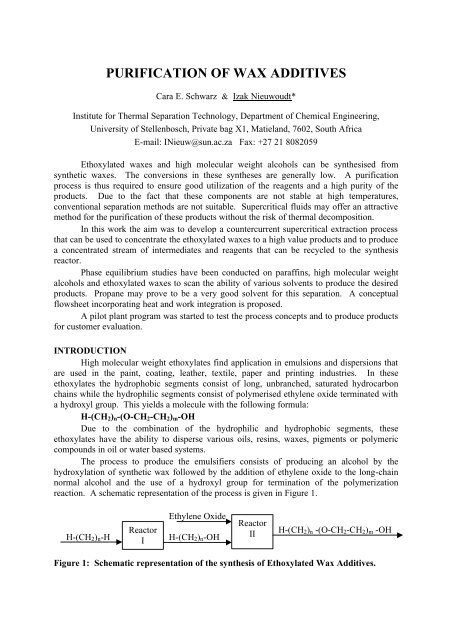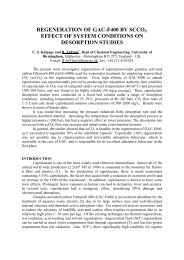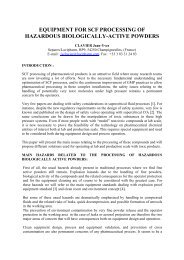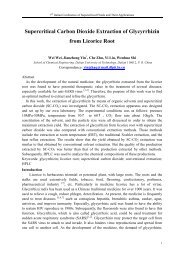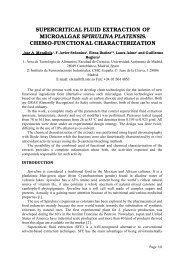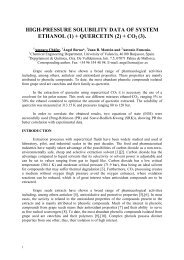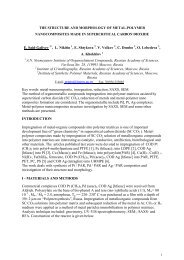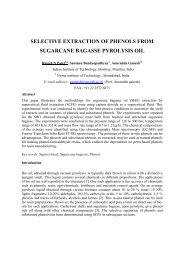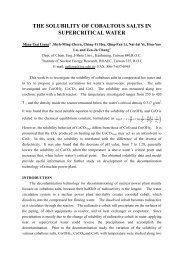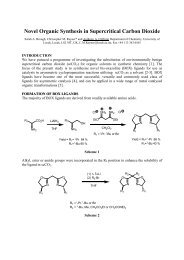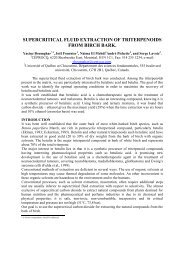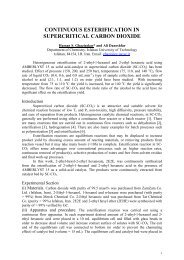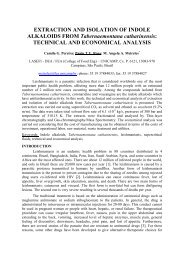PURIFICATION OF WAX ADDITIVES - ISASF
PURIFICATION OF WAX ADDITIVES - ISASF
PURIFICATION OF WAX ADDITIVES - ISASF
You also want an ePaper? Increase the reach of your titles
YUMPU automatically turns print PDFs into web optimized ePapers that Google loves.
<strong>PURIFICATION</strong> <strong>OF</strong> <strong>WAX</strong> <strong>ADDITIVES</strong><br />
Cara E. Schwarz & Izak Nieuwoudt*<br />
Institute for Thermal Separation Technology, Department of Chemical Engineering,<br />
University of Stellenbosch, Private bag X1, Matieland, 7602, South Africa<br />
E-mail: INieuw@sun.ac.za Fax: +27 21 8082059<br />
Ethoxylated waxes and high molecular weight alcohols can be synthesised from<br />
synthetic waxes. The conversions in these syntheses are generally low. A purification<br />
process is thus required to ensure good utilization of the reagents and a high purity of the<br />
products. Due to the fact that these components are not stable at high temperatures,<br />
conventional separation methods are not suitable. Supercritical fluids may offer an attractive<br />
method for the purification of these products without the risk of thermal decomposition.<br />
In this work the aim was to develop a countercurrent supercritical extraction process<br />
that can be used to concentrate the ethoxylated waxes to a high value products and to produce<br />
a concentrated stream of intermediates and reagents that can be recycled to the synthesis<br />
reactor.<br />
Phase equilibrium studies have been conducted on paraffins, high molecular weight<br />
alcohols and ethoxylated waxes to scan the ability of various solvents to produce the desired<br />
products. Propane may prove to be a very good solvent for this separation. A conceptual<br />
flowsheet incorporating heat and work integration is proposed.<br />
A pilot plant program was started to test the process concepts and to produce products<br />
for customer evaluation.<br />
INTRODUCTION<br />
High molecular weight ethoxylates find application in emulsions and dispersions that<br />
are used in the paint, coating, leather, textile, paper and printing industries. In these<br />
ethoxylates the hydrophobic segments consist of long, unbranched, saturated hydrocarbon<br />
chains while the hydrophilic segments consist of polymerised ethylene oxide terminated with<br />
a hydroxyl group. This yields a molecule with the following formula:<br />
H-(CH 2 ) n -(O-CH 2 -CH 2 ) m -OH<br />
Due to the combination of the hydrophilic and hydrophobic segments, these<br />
ethoxylates have the ability to disperse various oils, resins, waxes, pigments or polymeric<br />
compounds in oil or water based systems.<br />
The process to produce the emulsifiers consists of producing an alcohol by the<br />
hydroxylation of synthetic wax followed by the addition of ethylene oxide to the long-chain<br />
normal alcohol and the use of a hydroxyl group for termination of the polymerization<br />
reaction. A schematic representation of the process is given in Figure 1.<br />
H-(CH 2 ) n -H<br />
Reactor<br />
I<br />
Ethylene Oxide<br />
H-(CH 2 ) n -OH<br />
Reactor<br />
II<br />
H-(CH 2 ) n -(O-CH 2 -CH 2 ) m -OH<br />
Figure 1: Schematic representation of the synthesis of Ethoxylated Wax Additives.
The process for the conversion of the synthetic wax to the emulsifiers does not have a<br />
high conversion. A purification process for the material from the reactor is thus required to<br />
ensure good utilization of the reagents and a high purity of the emulsifier product.<br />
PROBLEMS WITH CONVENTIONAL <strong>PURIFICATION</strong> TECHNIQUES<br />
The problems with using conventional separation techniques such as distillation, liquid<br />
extraction and crystallization in processing high molecular weight compounds have been<br />
discussed by Nieuwoudt [1] and Crause [2].<br />
Since the polarity of the paraffins, alcohols and ethoxylates are different, it should be<br />
possible to find a liquid extraction solvent that can be used to separate these components.<br />
Removal of the solvent by evaporation is problematic since the components are temperature<br />
sensitive. Steam stripping may be used to get the solvent content of the products down to<br />
acceptable levels. Foaming of these compounds will complicate the steam stripping. Because<br />
of environmental concerns, clean up of the condensed steam also has to be effected.<br />
Technical and economic considerations thus stack up against liquid extraction.<br />
The melting points of the high molecular weight paraffins, alcohols and ethoxylates<br />
are very close which will make it impossible to obtain high purity products with fractional<br />
crystallization. Solvent crystallization will suffer from the same problems as liquid<br />
extraction.<br />
As the chain length of the components increase, the vapour pressure decrease. At<br />
temperatures below the onset of thermal decomposition the vapour pressure becomes so low<br />
that even short path distillation cannot be used to fractionate theses mixtures. Short path<br />
distillation also suffers from the fact that only one theoretical stage can be obtained per unit<br />
and that the operating costs are rather high.<br />
SCFE - AN ALTERNATIVE<br />
Although supercritical fluids should not be the first separation method to be<br />
considered, it may be an attractive alternative if traditional processes are not suitable. With<br />
specific reference to the system studied here, supercritical fluid extraction offers the following<br />
advantages [3]:<br />
• Lower operating temperatures, thus eliminating the risk of reducing thermal<br />
decomposition.<br />
• The tuning of solubility by changes in operating pressure.<br />
• The ability to separate between polar and non-polar substances.<br />
• Relative ease of solvent recovery.<br />
• Very low levels of solvent residue in the products.<br />
• The use of solvents that have FDA approval.<br />
SOLVENT SELECTION<br />
Carbon dioxide is the most widely used supercritical extraction solvent since it is<br />
cheap, non-flammable and non-toxic [3]. Du Rand et al. [4] investigated the solubility of<br />
alkanes (nC12 – nC36) in carbon dioxide and found that carbon dioxide is not a good solvent<br />
for high molar mass hydrocarbons, with nC36 being virtually insoluble in carbon dioxide at<br />
pressures below 25 MPa. The solubility of Unithox 550 ethoxylated wax (Baker Petrolite) in
carbon dioxide was measured at temperatures between 378 and 408 K. At wax mass fractions<br />
between 2 and 72 % no phase boundary could be detected below 25 MPa. The solubility of<br />
the corresponding Unilin 550 alcohol (Baker Petrolite) in carbon dioxide was also measured<br />
at temperatures between 378 and 408 K. As in the case of the ethoxylated wax, it was found<br />
that for wax mass fractions between 1 and 76 % no phase boundary could be detected below<br />
25 MPa. These results tie in with the work of Wiesmet et al. [5] where the interaction of<br />
carbon dioxide with polyethylene glycol (PEG) was investigated. They found that even for<br />
low molecular weight PEG carbon dioxide is sparingly soluble in the PEG phase at high<br />
pressures. Carbon dioxide will thus not work for this separation.<br />
From previous investigations [6,7,8,9] it is known that propane is able to dissolve high<br />
molecular weight paraffins. It was shown that propane could be used to fractionate high<br />
molecular weight paraffin mixtures [9]. If it’s higher polarity causes the alcohols and<br />
ethoxylated wax to be much less miscible with propane, propane may prove to be an<br />
interesting solvent for the fractionation of mixtures of waxes, alcohols and ethoxylates.<br />
EXPERIMENTAL DATA<br />
In the carbon number range of synthetic waxes (nC30 to nC90) a number of sources of<br />
data exist with propane as a solvent. Peters et al. [6] published propane-nC34 data, Peters et<br />
al. [7] published propane-nC60 data and Schwarz and Nieuwoudt [8,9] published data sets of<br />
propane-nC32 up to propane-nC60. It was found that for propane-nC60 at 408 K the mixture<br />
critical point is at less than 15 MPa.<br />
No phase equilibria data for propane-high molecular weight alcohol and propaneethoxylated<br />
wax could be found in the literature. However, Wiesmet et al. [5] studied the<br />
system PEG and found that the PEG is only sparingly soluble in propane. This result is<br />
significant due to the fact that the hydrophilic segment of the molecule is identical to<br />
polyethyleneglycol. The behaviour of the epoxilated wax in propane will thus be a<br />
combination of the soluble hydrocarbon segment and the nearly insoluble polyethyleneglycol<br />
segment. It is therefore necessary to measure the phase equilibria of supercritical propane<br />
with the ethoxylated waxes as well as with the high molecular weight alcohols.<br />
Unfortunately no pure components are commercially available to study the phase<br />
equilibria of high molecular weight alcohols or ethoxylated waxes with supercritical solvents.<br />
The Unilin 550 alcohol is a mixture of high molecular weight alcohols with approximately 20<br />
mass % paraffins. The average chain length of the material is 39. The Unithox 550 is an<br />
ethoxylated Unilin 550 and thus contains the ethoxylated material, unreacted alcohols and<br />
some paraffins. The phase boundaries for these Unilin and Unithox mixtures with<br />
supercritical propane were measured in the temperature range 378 to 408 K. The apparatus<br />
described by Schwarz and Nieuwoudt [8] was used.<br />
The results of the phase transition measurements are shown in Figure 2. It is evident<br />
that the difference in solubility beween the alkane and the epoxylated wax is quite large. The<br />
difference is even larger than is shown in figure 2 since the Unithox material contains some<br />
alcohol and paraffins. It is also evident that there is a large solubility difference between the<br />
ethoxylaed waxes and the high molecular weight alcohols. To separate between the paraffins<br />
plus alcohols and the ethoxylated wax will thus be rather easy.<br />
From figure 2 it is also evident that there is a substantial solubility difference between<br />
the paraffins and the alcohols. It should thus be possible to separate between the alcohols and<br />
the paraffins although the separation will be significantly more difficult than from the<br />
ethoxylated wax.
It is important to understand the phase behaviour of the alkane, alcohol and the<br />
ethoxylated wax in the propane. It has been proven that the phase behaviour of the alkane in<br />
propane is either type I or type IV [9] according to the classification system of Scott and van<br />
Konynenburg as cited by Bolz et al [10]. The exact phase behaviour cannot be determined as<br />
it is uncertain if a region of liquid-liquid immiscibily occurs (the alkane solidifies before this<br />
region can be seen). The propane-high molecular weight alcohols systems may also be type I<br />
or type IV since the phase boundary curves look similar to that of propane + paraffins. When<br />
the phase transition pressure pressures for the ethoxylated wax + propane is plotted as a<br />
function of mass fraction at various temperatures (Figure 3) it can be seen that above a mass<br />
fraction of about 2.2 mass % the gradient of the isopleth will change from positive to<br />
negative. By implication the system may be classified as type III according to the<br />
classification of Scott and van Konynenburg. A suitable temperature may thus be chosen<br />
where the alcohols and paraffins are fully miscible with propane but where the ethoxylated<br />
waxes are virtually insoluble even at very high pressures.<br />
Pressure (bar)<br />
300<br />
250<br />
200<br />
150<br />
100<br />
50<br />
0<br />
Alkane<br />
Alcohol<br />
Epoxilated<br />
0 0.2 0.4 0.6 0.8 1<br />
Mass Fraction Wax<br />
Pressure (bar)<br />
270<br />
250<br />
230<br />
210<br />
190<br />
170<br />
378 K<br />
393 K<br />
408 K<br />
0.010 0.015 0.020 0.025<br />
Mass Fraction Wax<br />
Figure 2: Phase transition data of<br />
propane + nC39 [9], propane + Unilin<br />
550 alcohol and propane + Unithox 550<br />
ethoxylated wax at 408.1K<br />
Figure 3: Phase transition measurement<br />
of propane + ethoxylated wax at various<br />
tempatures in the low mass fraction wax<br />
region<br />
CONCEPTUAL FLOWSHEET<br />
From the phase transition data it can be seen that the ethoxylated wax could be easily<br />
separated from the alkane and alcohol. A conceptual flowsheet for this separation is given in<br />
figure 4. Due to the ease of separation, a counter-current set-up without reflux is proposed.<br />
The extract stream that exits the extractor is expanded in a two-stage turbine with<br />
interstage re-heating. This is similar to what happens in steam power plants. The power<br />
recovered from these turbines is approximately the same as the power needed by the solvent<br />
recirculation pump. The residue, because of its low propane content, is expanded over a<br />
valve. The extract and residue streams then enter separation vessels where the propane gas is<br />
separated from the liquid products. The liquid products are heated to liberate some more<br />
propane. The liquid products then go to atmospheric flash drums (not shown) where the last<br />
propane is flashed off. Low-pressure steam is used in all of these heaters. The hot propane<br />
gas from the separators exchange heat with the propane from the solvent circulation pump to
get the maximum heat recovery. An air cooler is used to condense the propane at conditions<br />
just below its critical point. A low-pressure steam heater is used to bring the recirculated<br />
propane to the extraction temperature. Nieuwoudt et al. [11] has shown that this work and<br />
energy integration has a dramatic impact on the operating costs of this supercritical extraction<br />
system.<br />
Alkane + Alcohol<br />
to Reactor<br />
Propane<br />
Alkane, Alcohol +<br />
Propane<br />
Separation<br />
Vessel<br />
Alkane,<br />
Alcohol and<br />
Ethoxylated<br />
Wax from<br />
Reactor<br />
Propane<br />
Propane<br />
Storage<br />
Tank<br />
Ethoxylated<br />
Wax +<br />
Propane<br />
Separation<br />
Vessel<br />
Ethoxylated Wax<br />
Figure 4: Proposed Conceptual Flow Diagram<br />
CONCLUSIONS AND THE FUTURE<br />
With the aid of phase diagrams it has been shown that is should be possible to use<br />
propane as a supercritical solvent to separate between paraffins plus high molecular weight<br />
alcohols and heat-sensitive ethoxylated waxes. A conceptual flowsheet with heat and work<br />
integration is proposed.<br />
A pilot plant was constructed and pilot plant test based on the conceptual flowsheets<br />
will be conducted.<br />
The financial assistance of the South African National Research Foundation (NRF) towards<br />
this research is hereby acknowledged. IN gratefully acknowledges the support of the<br />
Alexander von Humboldt Stiftung.
REFERENCES<br />
1. NIEUWOUDT, I., The fractionation of High Molecular Weight Alkane Mixtures with<br />
Supercritical Fluids, PhD.Ing (Chem), 1994, University of Stellenbosch.<br />
2. CRAUSE, J.C., Supercritical Fluid Extraction of Paraffin Wax, PhD.Ing(Chem), 2001,<br />
University of Stellenbosch.<br />
3. BRUNNER, G., International Chemical Engineering, Vol. 30, 1990. p. 191<br />
4. DU RAND, M., NIEUWOUDT, I., Journal of Supercritical Fluids, Vol. 22, 2002. p.<br />
185<br />
5. WIESMET, V., WEIDNER, E., BEHME, S., SADOWSKI, G., ARLT, W., Journal of<br />
Supercritical Fluids, Vol. 17, 2000. p. 1<br />
6. PETERS, C.J., DE ROO, J.L., DE SWAAN ARONS, J., Fluid Phase Equilibria, Vol.<br />
72, 1992. p. 251<br />
7. PETERS, C.J., DE ROO, J.L., DE SWAAN ARONS, J., Fluid Phase Equilibria, Vol.<br />
85, 1993. p. 301<br />
8. SCHWARZ, C.E., NIEUWOUDT, I., Journal of Supercritical Fluids, In Press, 2003.<br />
9. SCHWARZ, C.E., NIEUWOUDT, I., Journal of Supercritical Fluids, In Press, 2003.<br />
10. BOLZ, A., DEITERS, U.K., PETERS, C.J., DE LOOS, T.W., Pure & Appl. Chem.,<br />
Vol. 70, 1998. p. 2233.<br />
11. NIEUWOUDT, I., CRAUSE, J.C., DU RAND, M. Supercritical Fractionation vs.<br />
Competing Processes: An Operating Cost Comparison. in 6th Conference on<br />
Supercritical Fluids and Their Applications. 2001. Maori, Italy.


